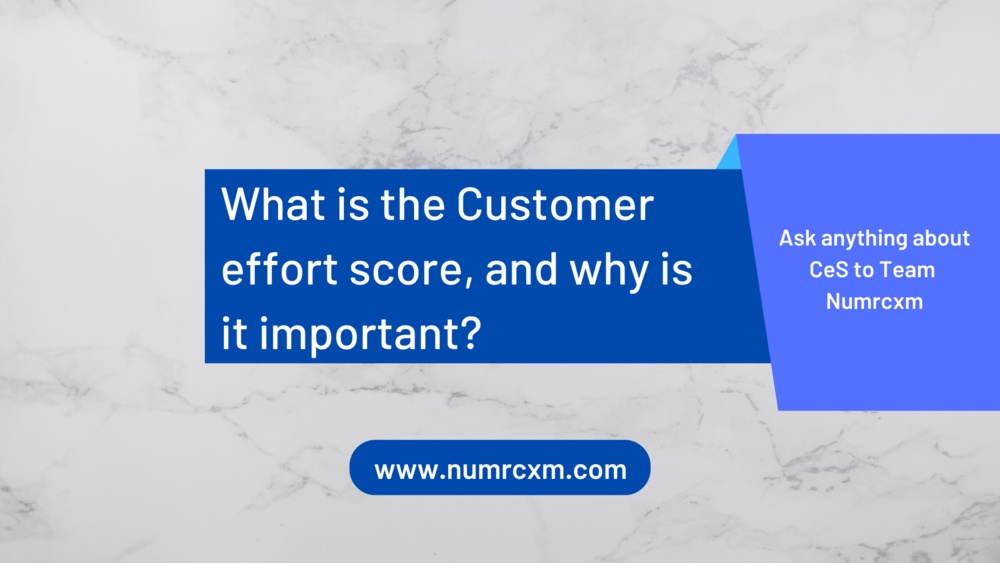Many people have these concerns as to what does CES stand for? The CES stands for Customer Effort Score, which measures how easy your customers perceive it to be to do business with you. It's based on the idea that if customers have high expectations of how hard it will be to deal with you, they'll take more time and effort to complete tasks. They'll take less time and effort if they have low expectations of how hard it will be to deal with you.

The customer Effort Score is a relative score calculated based on how your customers perceive the effort required to do business with you. It's not an absolute measure of how hard it is to do business with you, but instead, a comparison between one company and another. The Customer Effort Score is calculated by adding up all of the customer effort required to do business with you and then dividing that sum by the number of interactions a customer has with your company.
Why CES is important
The Customer Effort Score is a powerful tool for businesses because it allows you to measure the relative difficulty of doing business with you. The higher your score, the more effort customers will perceive your company requires of them. That is important because customers won't spend more time or money than they have to—if an alternative company can offer a similar product or service at a lower cost with less effort required, they'll take it every time.
The Customer Effort Score can help you identify where your customers feel you are spending too much time and energy doing business with you. You can then use this information to improve their experience and save time. The Customer Effort Score can also help you identify your competitors' weaknesses. If you see that a competitor has a higher CX, it might mean that they can afford to spend more on customer acquisition than you can. That could give them an advantage over you, but only if they use the extra money wisely. A higher CX score isn't always better—if a company spends more money on customer acquisition without increasing its revenue or profit, it may not be getting value from its increased spending.
CES is a crucial metric for tracking and understanding your customer's value. While many companies focus on the speed of their support, it’s far more important for companies to focus on the ease of their customer experience.
You can measure customer experience with a CX score, calculated by adding up the number of problems that customers report during a given period and dividing by the total number of interactions. A high CX score means a company has fewer problems per interaction, while a low CX score indicates more issues.
CES is an important metric to track and understand your customer's value. While many companies focus on the speed of their support, it’s far more important for companies to focus on the ease of their customer experience. The easiest way to measure CX is by looking at support tickets. If you’ve got a product with many moving parts and customers need help with their use, this can be an effective way to track your customer experience. But it’s not the only way. Companies like Google and Amazon have built robust tools that collect data on user behavior across their platforms—like how often people click on certain buttons or where they drop off while using an app.
CES and overall customer satisfaction (CSAT)
They are valuable metrics to track if you’re trying to gauge your CX. But they only tell part of the story and don’t help companies understand what causes people to leave. That’s why CES is much more important than CSAT. It helps businesses identify pain points in their customer experience to make changes before it costs them money.
CES can tell you what’s wrong with your product or service, while CSAT can only tell you how happy customers are with their experience. It’s one thing to know that people love your product, but it’s another to know why they loved it so much—and what made them leave.
CES is more than just a survey. It’s an analysis of your customer's experience and can get used to improve every aspect of their relationship with your company. When you know how customers feel about each interaction they have with your brand, you can make changes that improve their overall satisfaction with the product or service.
The CES survey
It is a powerful tool that can help you stay on top of what your customers want, but it’s important to know when and how to use it. Here are some tips for getting started with CES:
-Use CES as a way to learn. The survey is not just a way to measure satisfaction at the end of a project; it’s an opportunity to solicit feedback throughout the process so that you can make changes before things get out of hand.
-Keep your surveys short and simple. There’s no need to ask customers about every little thing they do when using your product or service—focus on those areas where you want the most input.
-Use CES to determine if your customers are happy. The survey can help you determine whether or not they’re satisfied with your product or service. If they aren’t, find out why so that you can make the necessary changes.
Tracking your CES score
All throughout your business life will help you determine how much effort you need to put into improving your product or service. If it’s consistently low, it’s time to make some changes; if it’s high, then keep doing what you’re doing.
There are many ways to improve your customer experience score, but the most important is to rely on the insights of those who use your product or service. If you want the best results, ask for feedback from those closest to your offer.
Conclusion
Hope now you are sure as to what does CES stand for? Having a good CES means your customers will stay with you longer, spend more money, generate more revenue and boost your brand image. That's great news for you. It is, but only if you do what it takes to get one. The steps to take in this are not complicated, but they require a deeper understanding of what the tool is doing than most companies currently have in place. In short: you need to understand the relationship between your effort costs and your effort investiture (the amount of work you put into being easy to do business with).


No comments yet